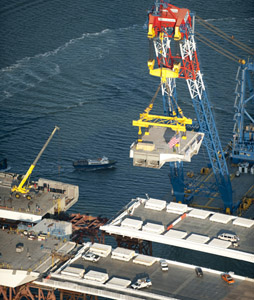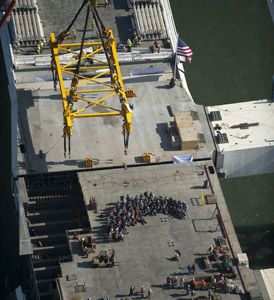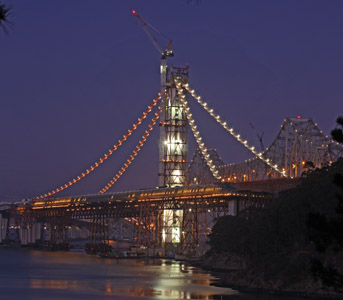Aided by the giant Left Coast Lifter crane, crews in October placed the last deck section on the new Bay Bridge East Spanís signature element, the soaring self-anchored suspension span (SAS).

The giant Left Coast Lifter crane carefully positions the last East Span deck section. © Barrie Rokeach 2011
By Brenda Kahn
Published: December, 2011
Aided by the giant Left Coast Lifter crane, crews in October placed the last deck section on the new Bay Bridge East Span’s signature element, the soaring self-anchored suspension span (SAS). The operation was a major milestone for the SAS, whose twin decks now meet up with the twin decks of the already completed Skyway portion of the new East Span. With the closing of the deck gap in the middle of the Bay, the two halves of the East Span have been fused into a continuous 1.7- mile pair of roadways stretching from the Oakland shore to Yerba Buena Island in a sweeping curve.
State and local officials and media gathered to witness the last stages of the operation to place the deck segment, which weighs 1,049 tons and is labeled as 14W — the W standing for the westbound deck, and the 14 indicating that it is the last of 14 pairs of SAS deck sections. The last segment sported banners saluting the ironworkers and operating engineers who have worked day and night to assemble the SAS tower and decks, which were fabricated in Shanghai.
The slowly descending piece formed a backdrop for the speakers, which included Acting Caltrans Director Malcolm Dougherty, Bay Area Toll Authority (BATA) Executive Director Steve Heminger and Brian Petersen, project manager for American Bridge/Fluor, which is the primary contractor on the job. Also on hand were officials from the bridge’s two anchor cities, signifying the East Span’s role in connecting the East Bay and West Bay: Oakland Mayor Jean Quan and San Francisco Public Works Director Mohammed Nuru (filling in for S.F. Mayor Ed Lee).
Quan said that the construction project represents the push for economic recovery, infrastructure investment and jobs, while also pointing to its importance for the seismic safety of the Bay Bridge’s 280,000 daily travelers. “We all felt the tremors last week. We know why we’re here today,” she said, referring to pair of unnerving October earthquakes centered in the Berkeley area.
Heminger likewise spoke to the seismic imperative to complete the East Span as quickly as possible. “Now that we have all the steel in place, I hope we can put the pedal to the metal,” he said. “Congratulations to all the workers who have gotten us this far, and let’s get the last stretch done now.” Once the speakers had concluded and the piece had set down, the relative quietude surrounding the delicate operation was broken as a small army of ironworkers sprang into action to detach the overhead Left Coast Lifter from the deck segment’s surface, the distinctive tools that dangle from their belts clanging like wind chimes. Afterward, the workers gathered on the SAS for their own informal celebratory huddle and photo session to mark the end of this phase of construction.
Although the SAS and Skyway decks are now essentially complete, an intentional gap will remain where they meet up mid-Bay. The space will be bridged by a seismic joint that will allow the two halves of the bridge to move independently of each other in the event of a major earthquake.
Meanwhile, work continues apace at either end of the completed SAS/Skyway decks. On the west end, crews are constructing a transition structure that will connect the side-by-side decks to the double-deck Yerba Buena Island Tunnel. On the east end, construction is proceeding on the Oakland touchdown. This latter project will require closure of the existing Bay Bridge’s westbound (upper) deck over a weekend in early 2012 to connect a detour. The detour will clear the way for completion of the touchdown.
Toward the end of 2011, attention will shift skyward as crews begin to pull the strands for the SAS’ nearly mile-long main cable. Crews recently completed the installation of the bright orange catwalks that outline the path of the main cable and that will serve as a platform for the cable operation. The catwalks are now illuminated during evening construction activities, giving a preview of how the stunning new East Span will transform the Bay’s skyline.
The Toll Bridge Program Oversight Committee — which is made up of BATA, Caltrans and the California Commission and is overseeing the new East Span — is aiming for a 2013 completion date for the project.

After the operation, the ironworkers gather to mark the completion of the East Span decks. © Barrie Rokeach

New lights on the East Spanís SAS catwalks illuminate the path of the soon-to-be installed main cable that will support the decks. Photo by Tom Paiva

